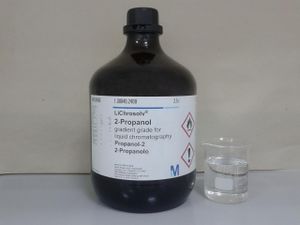Difference between revisions of "Isopropanol"
| Line 62: | Line 62: | ||
| MeltingPt_ref = | | MeltingPt_ref = | ||
| MeltingPt_notes = | | MeltingPt_notes = | ||
| − | | Odor = Alcoholic, | + | | Odor = Alcoholic, harsh |
| pKa = 16.5 | | pKa = 16.5 | ||
| pKb = | | pKb = | ||
| Line 167: | Line 167: | ||
[[Category:Peroxide forming chemicals]] | [[Category:Peroxide forming chemicals]] | ||
[[Category:Air-sensitive materials]] | [[Category:Air-sensitive materials]] | ||
| + | [[Category:Liquids]] | ||
Revision as of 22:33, 20 January 2020
 Isopropanol sample and its original bottle.
| |
| Names | |
|---|---|
| IUPAC name
2-Propanol
| |
| Systematic IUPAC name
Isopropanol | |
| Other names
Dimethyl carbinol; IPA; iPrOH; Propan-2-ol; Rubbing alcohol; s-Propanol; sec-Propyl alcohol
| |
| Identifiers | |
| Jmol-3D images | Image |
| |
| Properties | |
| C3H8O | |
| Molar mass | 60.10 g/mol |
| Appearance | Colorless volatile liquid |
| Odor | Alcoholic, harsh |
| Density | 0.786 g/cm3 (at 20 °C) |
| Melting point | −89 °C (−128 °F; 184 K) |
| Boiling point | 82.6 °C (180.7 °F; 355.8 K) |
| Miscible | |
| Solubility | Miscible with methanol, ethanol, benzene Insoluble in saline solution |
| Acidity (pKa) | 16.5 |
| Hazards | |
| Safety data sheet | ScienceLab |
| Flash point | Open cup: 11.7 °C (53.1 °F; 284.8 K) Closed cup: 13 °C (55 °F) |
| Lethal dose or concentration (LD, LC): | |
| LD50 (Median dose)
|
12800 mg/kg (dermal, rabbit) 3600 mg/kg (oral, mouse) 5045 mg/kg (oral, rat) 6410 mg/kg (oral, rabbit) |
| LC50 (Median concentration)
|
53000 mg/m3 (inhalation, mouse) 12,000 ppm (rat, 8 hr) |
| Related compounds | |
| Related compounds
|
Propanol Isobutanol |
| Except where otherwise noted, data are given for materials in their standard state (at 25 °C [77 °F], 100 kPa). | |
| Infobox references | |
Isopropanol, or isopropyl alcohol, is a secondary alcohol. It provides the familiar smell of rubbing alcohol, where it is frequently used although this may be ethanol. Isopropanol is the largest carbon chain alcohol to be miscible with water and is a common OTC solvent.
Contents
Properties
Chemical
Isopropanol is a generally nonreactive (inorganically speaking) alcohol. It can be dehydrated, and is a common reagent in organic chemistry.
Anhydrous isopropanol is used to neutralise small quantities of sodium or potassium metal, as the reaction with the alcohol is mild compared to with water and removes any reactive metal that may pose a danger if left in the lab. This property allows for the production of metal isopropoxides.
A violent runaway reaction happens when isopropanol comes into contact with a nitration bath. Toxic nitrogen dioxide is produced in a rapid reaction as the isopropanol is not nitrated but oxidised by the acids.
Isopropanol can be reacted with nitrous acid to for isopropyl nitrite and with mixed acids to form isopropyl nitrate.
Physical
Isopropanol is a clear, colorless liquid miscible in water. It's smell is described as closer to acetone than other short chain alcohols like ethanol. It burns on contact with cuts (like ethanol) and it's widely used as an antiseptic. It is a good, cheap solvent.
Availability
Isopropanol is available in concentrations anywhere from 60% to 99% (the rest being water and various stabilizers, additives) for a variety of applications, often cleaning electronics or sold as 'rubbing alcohol'. The most common concentrations are 70% and 91%. These store-bought solutions can be salted out up to a concentration of about 91% using sodium chloride, and nearly all water can be separated by salting out with sodium hydroxide, though this may inadvertently contaminate the isopropanol and produce sodium isopropoxide. Dry isopropanol has the potential to form explosive peroxides when distilled, so it is highly recommended that these distillations are carefully monitored if done at all.
Preparation
Isopropanol is produced by hydrogenation of acetone over a nickel catalyst. It can also be obtained by hydrolysing esters containing an isopropyl group.
Projects
- Chloroform synthesis
- Isopropyl chloride
- Isopropyl nitrite
- Isopropyl esters
- Diisopropyl ether
- Isopropanol peroxide (EXTREMELY DANGEROUS!!!)
Handling
Safety
Isopropanol is flammable. It has low toxicity and it's much less toxic than methanol or ethylene glycol. Vapours of dry isopropanol can potentially be explosive.
Storage
Isopropanol should be stored in closed bottles, away from any oxidants and fire sources. As it is prone to forming peroxides over long periods of time, a small amount of antioxidant should be added, unless it already has. Most OTC isopropanol already has antioxidants in its composition.
Disposal
Isopropanol can be safely burned. Old bottles that have been exposed to air should be checked for any peroxides and if there are any, they should be neutralized if safely possible.
References
Relevant Sciencemadness threads
- Chemical pages without CAS Registry Number
- Articles without EBI source
- Chemical pages without ChemSpiderID
- Chemical pages without DrugBank identifier
- Articles without KEGG source
- Articles without InChI source
- Articles without UNII source
- Articles containing unverified chemical infoboxes
- Chemical compounds
- Organic compounds
- Alcohols
- Secondary alcohols
- Solvents
- Polar solvents
- Protic solvents
- Volatile chemicals
- Readily available chemicals
- Essential reagents
- Peroxide forming chemicals
- Air-sensitive materials
- Liquids